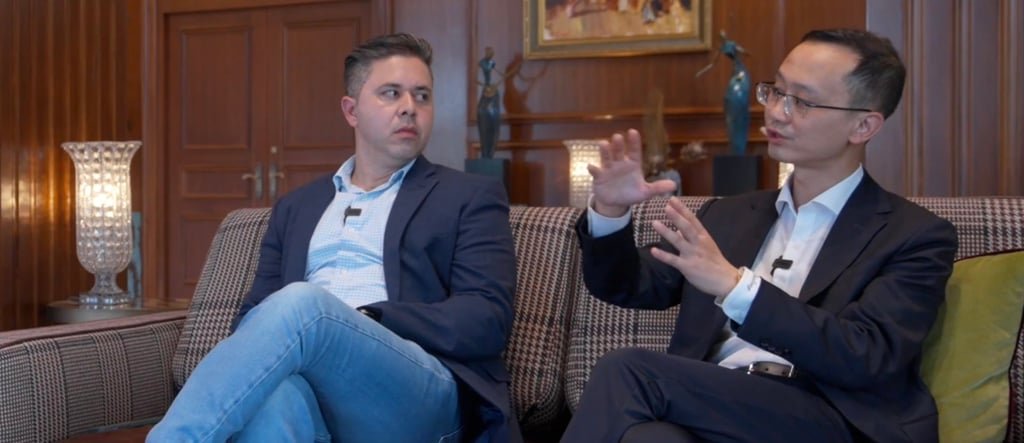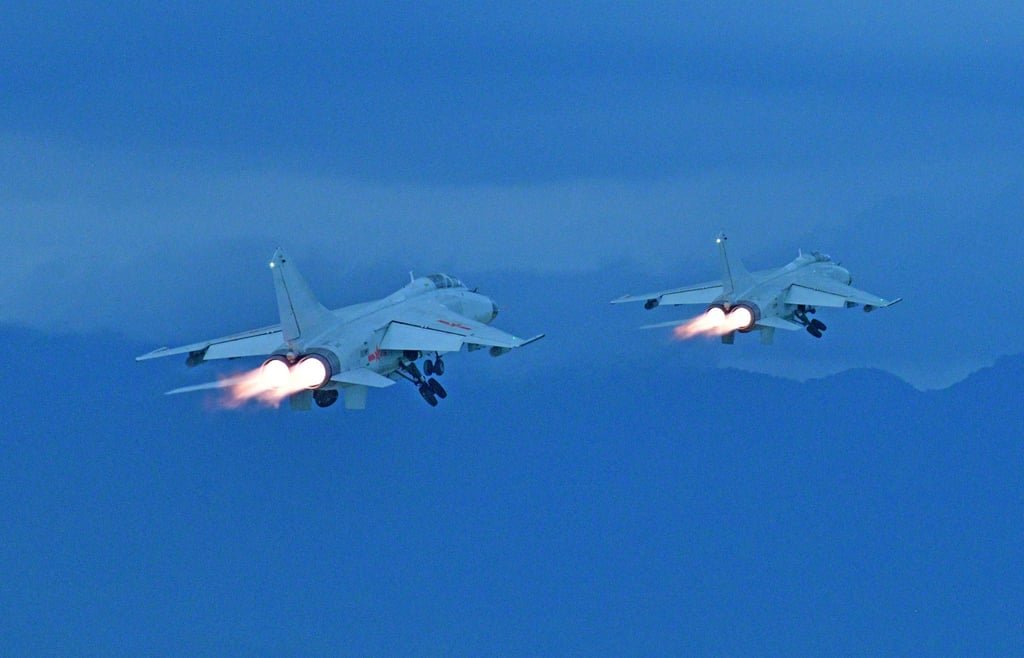ASTANA — As Kazakhstan and China enter a new golden era of strategic partnership, both countries are focused on real projects that will transform the energy system, said Kazakh Energy Minister Yerlan Akkenzhenov, opening the first Power Central Asia + China Forum in Astana on June 16.

Kazakh Minister of Energy Yerlan Akkenzhenov. Photo credit: Kazakh Ministry of Energy
The forum, held as part of the Central Asia-China Summit, brought together top officials, energy executives, and international investors to announce major agreements and chart a new course for regional energy cooperation.
The event aimed to translate the political will and high-level agreements made between heads of state into actionable projects. It is expected to result in the signing of key investment agreements and the launch of strategic initiatives that will enhance Kazakhstan’s energy security, accelerate the processing of raw materials, and support the country’s transition to a low-carbon economy.
Akkenzhenov emphasized Kazakhstan’s evolving role from resource exporter to energy technology hub, noting a significant shift in the structure of cooperation with China.
“Our relations have gone beyond raw material exports. We are building a joint, technologically rich ecosystem. As of today, 30 renewable energy projects with the participation of Chinese companies are being implemented, with a total capacity of 1,700 megawatts,” said Akkenzhenov.
Strategic energy agreements
Kazakhstan and China signed a series of major agreements to advance cooperation in energy, technology, and infrastructure. A framework agreement with PowerChina established strategic cooperation in technology localization, the creation of a research and development center, and the launch of a decarbonization fund.
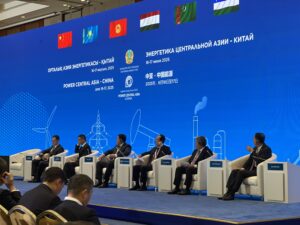
Power Central Asia + China Forum in Astana on June 16–17. Photo credit: Nagima Abuova / The Astana Times
China Southern Power Grid signed a memorandum with Kazakh partners to jointly develop projects in high-voltage direct current (HVDC) transmission, digital energy solutions, and pumped-hydro energy storage. Another memorandum with Huawei Kazakhstan outlined cooperation in digital transformation and cybersecurity across the energy sector.
A power purchase agreement was signed with China Energy Overseas Investment to supply electricity from the Sauran solar power plant in the Turkistan Region, which includes integrated energy storage systems.
QazaqGaz reached a financing agreement with China Construction Bank to support investment projects across its national gas infrastructure. The forum also featured an agreement with China National Chemical Engineering Construction Corporation International (CNCECI) to develop a feasibility study for a coal-to-chemicals plant capable of processing up to two billion cubic meters of gas annually.
Kazakhstan also signed a technological partnership with Sinopec to cooperate on advanced petrochemical processing and the development of high-value products. A final agreement brought together China Energy International, Shanghai Jiao Tong University, and Kazakh stakeholders to collaborate on hydrogen technologies and research and development initiatives.
Gas to power an AI-driven energy future
“Global energy consumption is driven not only by general industrialization, economic growth, and population increase, but also by a new factor that is changing the structure of consumption — artificial intelligence. Data centers that provide processing and computing power for artificial intelligence will consume significant amounts of electricity. In this regard, exponential growth in energy resource consumption is forecasted in the coming years. The primary source of electricity for these needs will be natural gas,” said QazaqGaz CEO Sanzhar Zharkeshov.

From left to right: Zhandos Nurmaganbetov, Sanzhar Zharkeshov, Zhang Heng, Yerlan Akkenzhenov, Ding Yanzhang, Nabi Aitzhanov, Lyu Zexiang. Photo credit: Kazakh Ministry of Energy
Zharkeshov also emphasized several unresolved challenges that hinder the development of the analytical energy market. He noted the failure to meet interim targets of the global energy transition, citing the lack of balance between energy reliability, affordability, security, and the shift to renewables. He also underscored the volatility of global energy policy shifts and called for a more pragmatic approach that prioritizes energy security.
“This is not paradoxical: to accelerate the process of decarbonization, it is necessary to increase the use of oil and gas energy resources. This means that the oil and gas sector will remain a priority in global energy markets for much longer than some environmental activists, who advanced impractical slogans, had anticipated,” Zharkeshov added.
Outlining Kazakhstan’s potential role in the regional energy landscape, Zharkeshov highlighted the country’s geographic position as a natural transport and logistics hub between China and Europe, reinforced by historic trade routes and growing transit capacity.
In 2026, Kazakhstan transported approximately 88 billion cubic meters of gas to domestic and partner markets.
“Kazakhstan has approximately four trillion cubic meters of recoverable marketable gas reserves, and approximately 62 trillion cubic meters of projected gas resources across 15 sedimentary basins. Only one-third of Kazakhstan’s territory has been explored. Enormous potential remains untapped,” said Zharkeshov.
He invited Chinese firms to join efforts in gasification, expansion of the Trans-Caspian corridor, transit growth, gas processing, and gas chemical development.
Grid, renewables and hydrogen plans
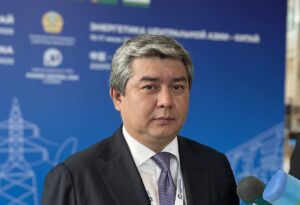
KEGOC Chairman Nabi Aitzhanov. Photo credit: Nagima Abuova / The Astana Times
Kazakhstan Electricity Grid Operating Company (KEGOC) Chairman Nabi Aitzhanov presented Kazakhstan’s plan to add 32 gigawatts of generation capacity by 2035. Nineteen gigawatts will come from renewables. He emphasized the need for flexible systems and up to three gigawatts of storage, with half of it directly linked to renewable projects.
To integrate this growing share of renewables into the national grid, Aitzhanov highlighted four key focus areas. The first is demand-side management and digitalization, with a dedicated program being developed. The second involves expanding and constructing electrical networks, with ten large-scale projects already included in national planning documents.
The third priority is the development of flexible generation, with 6.5 gigawatts of gas-fired capacity planned by 2035 to support grid stability. The fourth is energy storage systems, with plans to introduce up to three gigawatts of storage capacity. Half of this will be implemented alongside large-scale renewable projects, while the rest will be developed through competitive auctions and balancing market mechanisms.
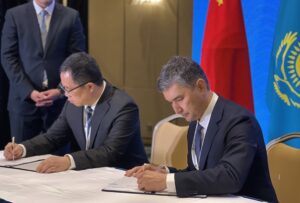
Bakhytzhan Ilyas, vice minister of energy, signs a memorandum with Huawei Kazakhstan on cooperation in digital transformation and cybersecurity in the energy sector. Photo credit: Nagima Abuova / The Astana Times
“Our focus is on demand-side management, flexible generation, and expanding transmission infrastructure,” Aitzhanov said.
Bakhytzhan Ilyas, Kazakhstan’s vice minister of energy, outlined the country’s energy development concept.
“Last year, the ministry approved a hydrogen energy development concept through 2035. The concept outlines the need to develop hydrogen production, storage, and transportation. Currently, there is strong demand from European countries, particularly Germany, which views Central Asia as a potential exporter of this strategically important energy source. In response, Kazakhstan is conducting research on hydrogen potential and transport technologies in cooperation with both European and Chinese partners,” said Ilyas.
Regional energy infrastructure outlook
Zhang Heng, China Southern Power Grid CEO, introduced the company’s vision for the region.
China Southern Power Grid is a key enterprise in China’s energy and power grid utility sector and a global leader in the construction and operation of digital energy infrastructure. The company’s annual electricity generation exceeds one trillion kilowatt-hours, serving a population of 272 million across 130 million households. The company’s total assets exceed $160 billion.
“At present, China and the five Central Asian countries are at a crucial stage of socio-economic development, which places higher demands on clean, safe, and efficient electricity supply (…) We are confident that, under the Belt and Road Initiative, we will achieve excellent results together,” he said.
Power China: green energy vision
Chinese energy executives also voiced confidence in the strategic direction of the partnership.
“The friendship between China and the Central Asian countries has deep roots and continues to grow stronger over time. Energy remains a key area of bilateral cooperation,” said Ding Yanzhang, the chairman of the board of PowerChina.
“At the first China-Central Asia Summit, Chairman Xi Jinping proposed establishing an energy development partnership between China and Central Asia to foster a closer community with a shared future under the Belt and Road Initiative. In this context, PowerChina is actively implementing the consensus reached by the heads of state and deepening practical energy cooperation with Central Asian countries,” he said.

The forum united officials and investors to advance regional energy cooperation. Photo credit: Nagima Abuova / The Astana Times
Yanzhang noted that since entering the Central Asian market in 1999, PowerChina has adhered to a green development approach, implementing landmark projects in hydropower, wind energy, and photovoltaics in Kazakhstan, Uzbekistan, and Tajikistan. These projects have provided safe, environmentally friendly, and high-efficiency energy solutions.
“As the global energy landscape undergoes profound transformation, the shift toward green and low-carbon development has become a widely shared goal. Central Asia, as a key region for energy cooperation under the Belt and Road Initiative, is expected to play an important role in regional, Eurasian, and even global energy development,” he said.
“With its abundant resources and growing potential, Kazakhstan offers vast opportunities, and PowerChina is ready to actively participate in the country’s energy transition and innovation efforts alongside all partners,” he added.
Investment priorities in new energy
“To date, Kazakhstan, Tajikistan, the Kyrgyz Republic, and Turkmenistan have issued policy documents aimed at strengthening international cooperation in the field of new energy and accelerating green development. This demonstrates that the countries of Central Asia have moved from vision to action in advancing the green transformation,” said China Energy International Chairman Lyu Zexiang.
He highlighted the company’s $3.6 billion investment across 20 regional projects, as well as its focus on renewable energy.
“These projects primarily cover photovoltaics, wind energy, energy storage, and construction materials. The company also holds 50 contracted projects with a combined value of nearly $10 billion, more than 50 percent of which are in the new energy sector,” said Zexiang.
Zexiang noted that China Energy, a global leader in the energy and power sectors, adheres to the path of green transformation. The company focuses on four core business areas, including new energy, new infrastructure, new materials, and emerging industries, promoting shared use and integration to accelerate the creation of world-class enterprises.




